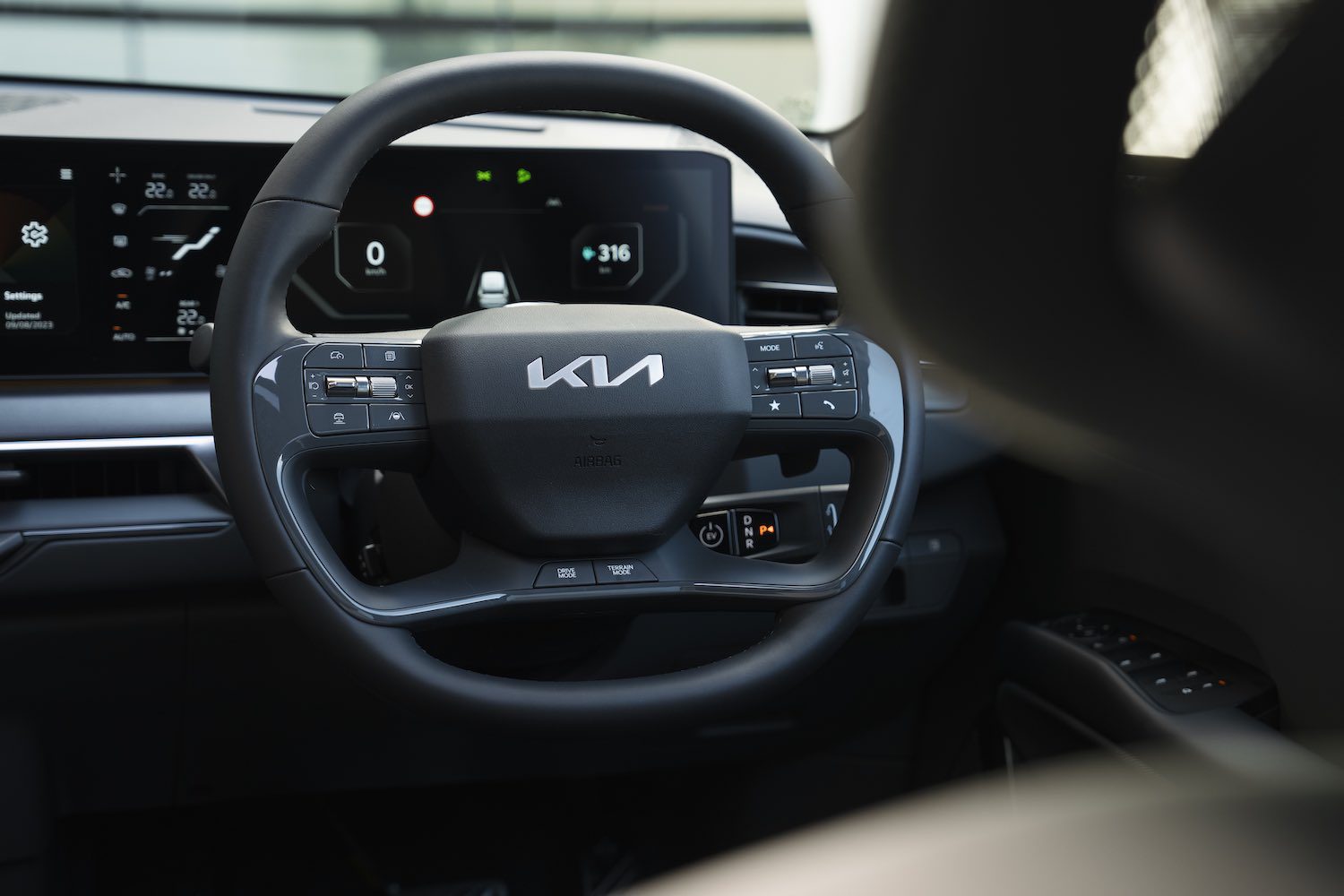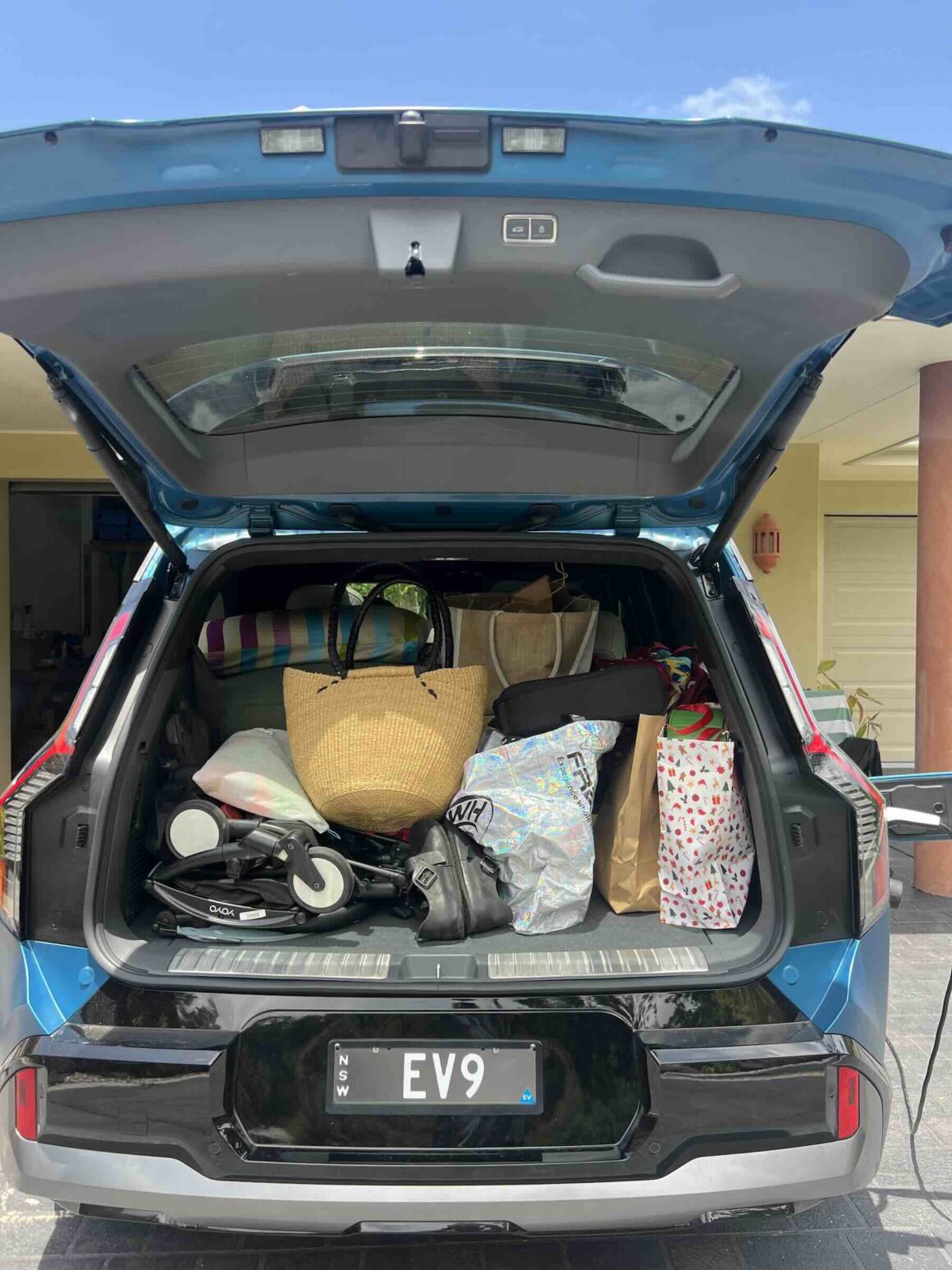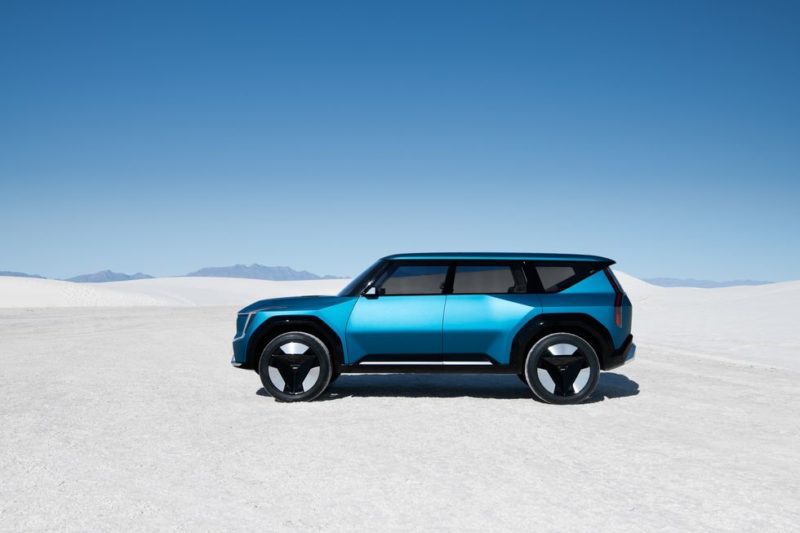This probably won’t be the first review of Kia’s EV9 that you read. In fact, it’s not even the first review of the EV9 that I’ve written, having test driven the electric 7-seater during the Australia launch back in 2023.
During that launch I was given an EV9 to share with another journalist as we drove in a pack to the southern highlands of NSW for a lunch on the water, followed by an extraordinary dinner at a private residence with beautiful views of the coast.
A year later I had an opportunity to revisit this flagship electric vehicle from Kia and test it on a long-haul road trip from Sydney to Byron Bay and back. This time, there wouldn’t be presentations, 5-star hospitality, nor the novelty that comes with a brand-new vehicle to our shores.
On this trip, the friendly journalist would be replaced by my two-year old son. The champagne lunch would be replaced with a servo sausage roll, and the boot would be filled to the brim with family suitcases and Christmas presents.
Given the new set of circumstances, I felt the question of whether the EV9 is truly as good as I wanted it to be would be properly answered.
I’d be driving the GT-Line version (the model’s top-spec priced at $121,000 before on road costs). Despite already being a car that’s hard to miss due to its size and rather unique look, the number plate EV9 really made it hard to miss. People driving past me likely thought I was either on the way to a Kia commercial set, or that I was Australia’s #1 Kia fan such that I had the number plate customised to the model of Kia I was driving.
During the launch test drive in 2023 there was a bit of chatter around the safety features of the EV9. It wasn’t chatter about the lack of safety features, to the contrary it was about the sheer amount of them.

I won’t go over the list of features again in this review, if you want that you can find it here in Tim Eden’s great writeup of his experience with the EV9. But the feature that perhaps caused the most chatter was the Driver Attention Warning (DAW).
Sensors attached to the steering wheel constantly monitoring your eye movement, and letting you know if the car did not approve of your eyes’ behaviour via a subtle alarm warning. I found this system overzealous for most of my trip and eventually got into the habit of turning it off when starting up the car (turning it off permanently is not an option).
The cockpit in the EV9 is one of my favourite things about it. It’s spacious. The mesh headrest (available on all models) honestly makes this one of the most comfortable car seats I’ve sat in. On the GT-line, the addition of ventilated seats and massage functionality makes it even better.
The virtual sideview mirrors (GT-Line only) were much easier to adapt to than I initially feared. While not a big fan of the haptic menu buttons, I love the long, customisable triple-panorama display. My only major issue with the physical layout of the cockpit was not being able to adjust the steering wheel up high enough so someone my height (6”5) could see the full cluster behind the wheel.
The DAW system however seemed to be obsessed with making sure I didn’t have more than the slightest of glances at this cluster of driver information without giving me a warning. Glancing at the virtual mirrors? That’s a paddling. Glancing at the infotainment dash with map information? That’s a paddling. Checking the virtual rear-view mirror? You better believe that’s a paddling.
Feeling frustrated at this horrible case of a back seat driver and that I wasn’t being given adequate flexibility to check various parts of the cockpit without getting a slap on the wrist, I turned off DAW. But it didn’t end there.
The EV9 appeared to still take note of my eye movement behaviour. Eventually after sufficient build-up of prohibited glancing, the cluster would display a coffee sign and sound a loud-ish alarm.
The first time this happened, I wasn’t sure what was happening as the coffee icon was hidden behind the steering wheel in a part of the cluster I couldn’t see. When I eventually found the coffee icon, I had a good 3-minute period of intense, prohibited glancing to try and figure out how to turn off the alarm, which was also posing a threat to my toddler’s nap in the backseat.
The only way to turn it off was to literally pull the car over and come to a stop, not an ideal activity when cruising at 110km/h on a highway. As much as I appreciated the vehicle’s concern for my caffeine levels, it just wasn’t a good time nor place to take a pit stop.
Whether this was an intentional part of the safety feature design I still don’t know, but the few minutes it took for me to try and investigate the source and purpose of the alarm, and then to understand how to turn it off, was without doubt the most dangerous part of the entire trip. This intrusive reminder to have a coffee break repeated about 3-4 times during the drive back down to Sydney.
Moving on beyond the cockpit, the rest of the car (there’s a lot of it) is, well, big. Nice big I should say. I like the second-row chairs being able to swivel 180° to face the third row. However, with the booster seat installed this wasn’t a feature we could make use of.
Folding the third-row seats down made for an impressive amount of space (which we gladly used up) for luggage etc. Keep the third seats row upright however and the boot doesn’t seem so large. Where a family of 6 or 7 would put their luggage was a thought that popped up. But then again, what other EV can offer 7 seats and a large boot? (genuine question feel free to comment if you do know).

Fast charging up the coast was easy, once I was plugged in. Peak holiday season up the east coast can require patience particularly if you don’t have access to Tesla’s supercharger network.
A combination of underperforming (or in some cases non-performing) charging stations, combined with high demand and the not so occasional lapse in charger courtesy from some other drivers (if you charge up to 100% while people are waiting for the charger I’m talking directly to you), means you are better off accounting for some extra travel time.
Once plugged in, the EV9 can charge from 10%-80% in 24 minutes on a 350kW DC charger. Well that’s what Kia says anyway, I’ve never actually been able to get a charger to get up to that speed.
Nevertheless I was usually charging from around the 40% mark to the 80% mark, needing no more than 25-30 minutes. Just enough time to change a nappy, consume a servo sausage roll, and have a stretch.

The EV9 Earth and GT-line AWD models comes with 283 kW power and 700Nm of torque, it accelerates from 0 to 100km/h in approximately 5 seconds. Entirely unnecessary for a family car, but also very fun. Unfortunately, I was banned by my wife from putting the pedal anywhere close to the floor after the first couple of attempts.
It really did feel incredibly fast, particularly for a car of that size. The EV9 does a good job of masking its size around corners, and the car has a nicely balanced feel. Interior cabin noise is minimal with regard to wind, not that I would have noticed too much with the delightful sounds of The Wiggles, Raffi, or Baby Shark on rotation. It really is a nice car to drive that feels big, powerful and somewhat luxurious all at once.
In terms of economy I would average around the 21kWh/100kms mark, which in my view is more than respectable on a highway and considering the size of the vehicle.
After driving up to Byron Bay and back down to Sydney, I found myself trying to come to a succinct conclusion about the EV9. But I struggled a bit to do so. It’s a bold car, in terms of its size, its look, features, and arguably its price. My initial reaction to the price (starting at the around the $100k mark) is to scoff somewhat at that price tag being attached to a Kia.
I don’t say this with any disrespect to Kia. Over the past decade Kia have done a remarkable job of positioning themselves away from a budget car brand to a sporty, more upmarket brand with vehicles worthy of the higher price tags. And in my view with great success, but people are still catching up with this transition.
Kia I think have some of the best EV models out there, including the EV6, and more recently the EV5. I’d also challenge the skeptics to compare what the EV9 offers compared to other popular non-electric family SUV models on the market such as the 2025 Toyota Prado (priced at around $100k drive away), or other similar products from Range Rover and Audi. The EV9 price tag may not seem so out of touch.
Back to my conclusion, and it has to be subjective. I like the look of the car, I think it’s great to drive. I like the space, cabin features including the 180° rotating seats. I like that it still feels zippy and fun to drive despite being absolutely massive.
I like that it has V2L and V2G capability. I don’t like the DAW safety feature, I don’t like parking the car in tight spaces. If I was looking for a large family SUV, the EV9 would stand out as a good option to consider, given I would gladly use it for road trips up and down the coast for years to come.

Sam is Chief Operating Officer for Renew Economy and EV Media. Sam has been working with Renew Economy and One Step Off The Grid since 2014 and with The Driven since its inception in 2017. Sam is also the host of The Driven Podcast.


